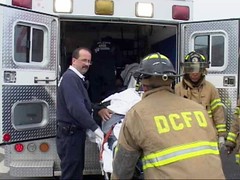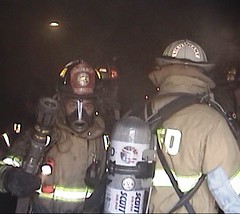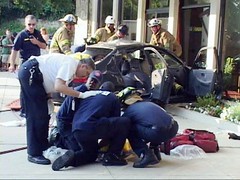The "recent" failures of the DC Fire Department are indicative of much deeper systems failures than people realize
 When you see this or hear the sirens... (photo from DCFD.com)
When you see this or hear the sirens... (photo from DCFD.com)In the early 1990s I used to work on television production about enterprise computing. At the time, I read the journal Communications of the ACM. And on the back page they have a column called "Inside Risks." Peter G. Neumann moderates the ACM Risks Forum and he's authored the book Computer-Related Risks, which covers:
1 THE NATURE OF RISKS
2 RELIABILITY AND SAFETY PROBLEMS
3 SECURITY VULNERABILITIES
4 CAUSES AND EFFECTS
5 SECURITY AND INTEGRITY PROBLEMS
6 THREATS TO PRIVACY AND WELL-BEING
7 A SYSTEM-ORIENTED PERSPECTIVE
8 A HUMAN-ORIENTED PERSPECTIVE
9 IMPLICATIONS AND CONCLUSIONS
While this forum focuses primarily on systems design issues involved with technology, usually computing systems, there is a Society for Risk Analysis and the field, based on systems analysis, addresses risk analysis in all its dimensions.
I was talking with Dan Wolkoff last night at an opening at Wohlfarth Galleries, and he had some important insights into the DC Fire and Emergency Medical Services systems failures that have come to our attention because of the death of David Rosenbaum.


 You think it's an emergency, a matter of life and death (photos from DCFD.com)
You think it's an emergency, a matter of life and death (photos from DCFD.com)Some people think Dan is a crank, because he is known far and wide for his advocacy-complaining about emergency vehicles (over)using their sirens on the way to Providence Hospital. Since Dan lives a couple doors down from the major route to the hospital for emergency vehicles, he is sick and tired of the sirens, and he makes his views known.
Anyway, we were talking about the recent Inspector General's report on the debacle (click here for the IG testimony to the City Council) and the recent City Council Committee on the Judiciary hearing, and Dan said he wanted to submit some testimony.
Dan focuses on how the system is organized and what it accomplishes on a daily basis. Mostly Mr. Rosenbaum's death has been addressed as the result of a broad problem of incompetence and a lack of accountability (which is true), but merely as another example of the normal incompetence of the DC Government and what Colbert King, in his Saturday columns in the Post, calls the "DC Boogie."
Dan believes that the problem is much deeper and systemic and goes beyond the sorry myriad failures that in combination, in all likelihood led to the premature death of Mr. Rosenbaum.
First, Dan says, most of the non-fire "emergency" calls the Fire Department makes are routine, non-emergency matters, and that perhaps even a majority of the people transported by DC FEMS to hospital emergency rooms don't really need to go there, but have no other medical provider handy. This is something we suspect to be true, and take for granted, but...
WHAT HAPPENS is that the non-emergency nature of most of their calls desensitizes Fire Department personnel to emergency situations, and makes it difficult for them to respond differently when the situation demands it.
Second, why shouldn't Fire Department personnel have thought that Mr. Rosenbaum was drunk? After all, for all the sirens and rushing to calls, most DC Fire and Emergency Services "emergency" calls are alcohol-related, mostly responding to and attending to inebriates.
Mr. Rosenbaum was sprawled on the ground, just like most of the people that DC Fire Department emergency personnel attend to on a daily basis when making EMS calls.
Why should Mr. Rosenbaum have been any different from most of their other calls--that day, that week, that month, that year?
 But most of the time it's not that simple. Image by Tozzophoto.
But most of the time it's not that simple. Image by Tozzophoto.In January 2004, the Seattle Times reported, in "Seattle may extend alcohol-sale limits to much larger area," that:
An estimated 2,000 chronic street alcoholics live in King County, nearly all in the three downtown Seattle zip codes. The 20 worst offenders among them cost an estimated $2 million a year for police, medical, ambulance and transportation, according to the King County Department of Community and Human Services. ...
The Liquor Control Board's "alcohol-impact area" ordinance has been controversial since it was created in 1999, criticized by merchants, as well as human-services advocates. "The end goal of the AIA effort is not necessarily to cure the alcoholism," said Lorraine Lee, head of the Liquor Board's regulations division. Instead, it is intended to mitigate "the concentration of negative impacts ... that affect the neighborhood livability."
Tacoma got the first impact area in the state in 2001, covering a 6-square-mile area of downtown and the Hilltop area. Unlike Seattle's proposed ban, which would prohibit all sales of single cans of beer, Tacoma's ordinance blacklists 40 high-alcohol brand names. By the Liquor Control Board's definition, the ordinance has been a success. Alcohol-related ambulance calls dropped 35 percent in the first year, and admissions for detoxification admission fell 21 percent, according to a Washington State University study. .
Relatedly, in "MILLION-DOLLAR MURRAY: Why problems like homelessness may be easier to solve than to manage," Malcolm Gladwell writes about related issues of alcoholism and homelessness and the difficulty of addressing the problems with typical social and public policy responses. Without a broader set of social and public policy responses put in place, too often the Fire Department ends up dealing with this, by picking up super-inebriated individuals and carting them off to the hospital.
I have no reason to believe that DC is any different. I've witnessed a few of these calls on H Street, one where the personnel hosed off a person because of the filth, before they were willing to place him into the ambulance. And I've called 911 myself after finding people sprawled on the sidewalk, completely unresponsive.
Clearly, there is a systems analysis issue here of major proportions. I think Dan is on to something.
Related stories:
-- Wall Street Journal Examines New Hospital Communications Standards Examined To Prevent Medical Errors
-- A simple, fast cure for ailing hospitals. From this op-ed from the Baltimore Sun:
The report made the "worst possible recommendation" for addressing problems at U.S. emergency departments in saying Congress should create a new federal agency and allocate billions of dollars. ... "systems thinking" -- a concept of "focus[ing] on the person or customer and his or her satisfaction" -- should be used to improve the quality of hospital care instead of the IOM recommendation because systems thinking "does not require more staff or expensive consultants, and it certainly does not need another bureaucratic, costly and inefficient government agency, which can only make things worse." Systems thinking "is being tried at several hospitals throughout the country, reducing patient waiting time, dramatically cutting costs and delivering quality care to patients..."
-- U.S. EMERGENCY CARE System Overwhelmed, Unprepared For A Disaster, IOM Report Says (much of this is due to non-emergency care overwhelming emergency rooms and local emergency responders)
-- Silver Spring Hospital Struggles to Serve: Immigrants Swell Uninsured Ranks At Holy Cross
-- and past writings in this blog about plans for a new hospital in DC called the "National Capital Medical Center" such as "Piling on the Hospital Issue."
Here are some of the chapter subsections of Dr. Neumann's book which are relevant to this sorry situation:
1.2 Sources of Risks
1.3 Adverse Effects
1.4 Defensive Measures
2.1 Communication Systems
3.4 Resource Misuse
4.1 Weak Links and Multiple Causes
4.2 Accidental Versus Intentional Causes
5.4 Intentional Denials of Service
5.5 Unintentional Denials of Service
7.3 Distributed Systems
7.4 Woes of System Development
7.5 Modeling and Simulation
7.6 Coping with Complexity
7.7 Techniques for Increasing Reliability
8.1 The Human Element
8.2 Trust in Computer-Related Systems and in People
8.4 Mixed Signals on Social Responsibility
8.5 Group Dynamics
9.1 Where to Place the Blame
9.2 Expect the Unexpected!
9.3 Avoidance of Weak Links
9.4 Assessment of the Risks
9.5 Assessment of the Feasibility of Avoiding Risks
9.6 Risks in the Information Infrastructure
9.8 Avoidance of Risks
That's a lot of reading...
Index Keywords: risk-analysis; public-safety



0 Comments:
Post a Comment
<< Home